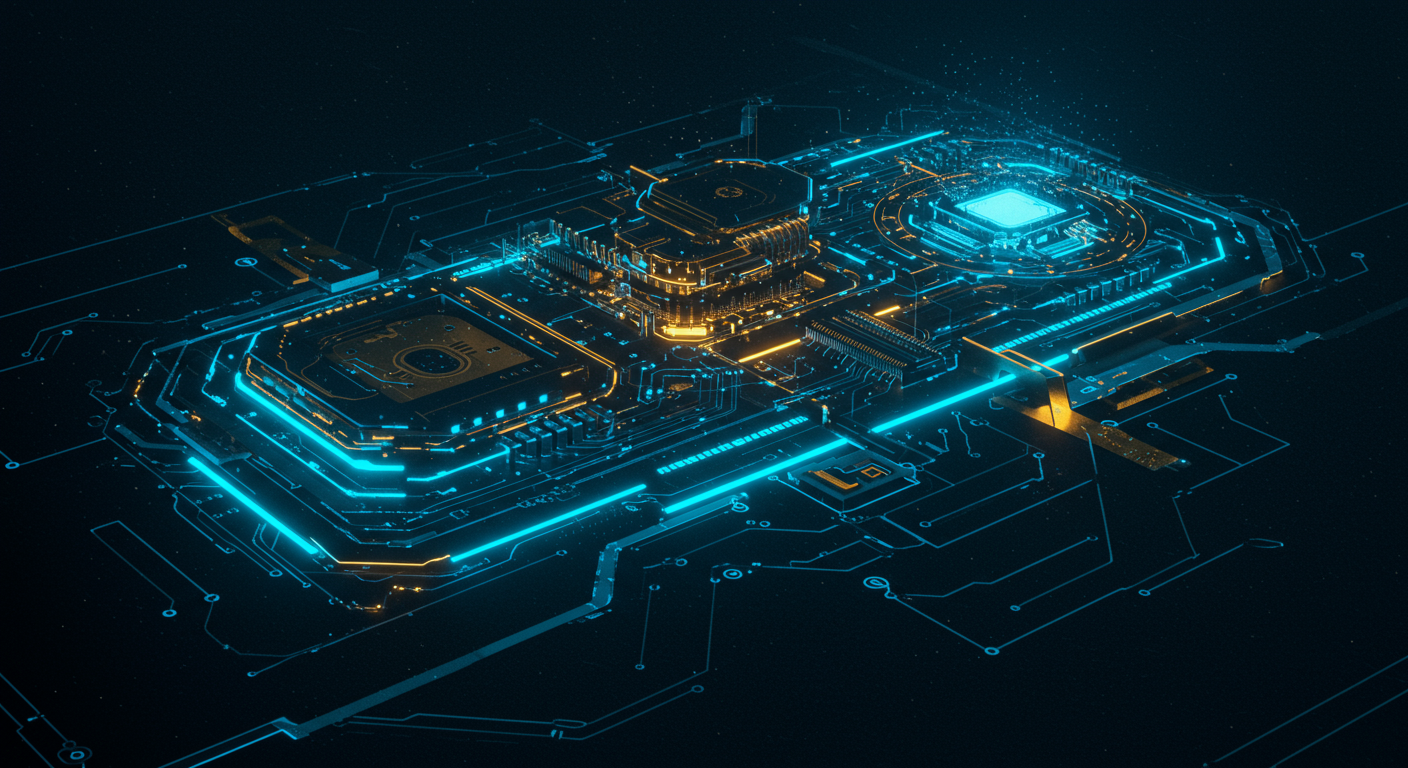ReasoningBank: How Google's AI Memory Framework Will Revolutionize LLM Agents

ReasoningBank is not just memory; it's a strategy for LLMs to remember how they reason.
Understanding the ReasoningBank Concept
ReasoningBank represents a significant leap forward in AI agent memory frameworks, operating at the "strategy-level." It's not just about storing information; it's about helping Large Language Models (LLMs) to self-evolve and improve their reasoning capabilities during use. Think of it as an LLM's ability to learn from its past "thought experiments."
Deconstructing the 'I Agent' Terminology
The term "I agent" is key. In the context of a ReasoningBank architecture, it signifies an "Introspective agent"– one capable of examining its own thought processes. ReasoningBank allows these agents to:
- Reflect on previous reasoning steps
- Identify successful strategies
- Adapt their approach in real-time
How ReasoningBank Differs from Traditional Systems
Traditional LLM memory systems and knowledge bases typically focus on storing facts and data, similar to a static library. ReasoningBank, however, enables a dynamic, strategy-level agent memory, leading to continuous improvement. Consider these differences:
Where a traditional system might store 'Apples are red', ReasoningBank tracks 'When faced with ambiguous data, cross-reference multiple sources before making a conclusion'.
The Revolution is Self-Evolution
By tracking and learning from its own reasoning processes, ReasoningBank helps LLM agents move beyond rote memorization and achieve genuinely adaptable problem-solving skills. This has huge implications for fields like scientific research and complex problem solving. The power to evolve during test time changes everything.
ReasoningBank isn't just another AI system; it's a memory framework poised to transform how LLM agents function.
Key Components and Architecture of ReasoningBank

ReasoningBank's architecture revolves around a few key components that work in concert to enhance reasoning and learning capabilities in Large Language Models. Let's dissect them:
- Memory Modules: These modules store diverse types of information, from facts and observations to intermediate reasoning steps. Think of it as a well-organized digital attic, except the items inside are constantly being re-evaluated and reorganized.
- Reasoning Engine: This is the core that utilizes the stored information to perform logical inferences, problem-solving, and decision-making. It's the engine that separates ChatGPT, a well known chatbot and AI assistant, from something truly intelligent.
- Retrieval Mechanism: The system needs a way to fetch the most relevant information from its memory.
Data Flow and Interactions
The real magic happens in how these components interact, imagine this data flow:
- Input arrives, triggering the Reasoning Engine.
- The engine consults the Retrieval Mechanism to pull relevant memories from the Memory Modules.
- Inferences are made, and new insights are generated.
- The new insights are then stored back into the Memory Modules, enriching the system's knowledge base.
Underlying Algorithms and Techniques
ReasoningBank uses various algorithms and techniques, including:
- Knowledge Graph Embeddings: Representing knowledge in a structured graph for efficient retrieval and reasoning.
- Attention Mechanisms: Allowing the model to focus on the most relevant pieces of information during reasoning. These techniques go beyond simple keyword matching and delve into semantic relationships.
Handling Noisy or Conflicting Information
This Google AI memory framework architecture is designed to deal with the messiness of real-world data. It employs strategies such as:
- Confidence Scoring: Assigning scores to information based on its source and consistency.
- Conflict Resolution: Identifying and resolving inconsistencies through logical inference and evidence evaluation. This is critical for real-world applications where AI needs to sift through biased or inaccurate data.
One of the most exciting promises of AI agents is their potential to learn and improve autonomously, essentially achieving LLM self-evolution with ReasoningBank.
How ReasoningBank Enables Self-Evolution in LLMs
ReasoningBank is a framework designed to enable LLMs to store, retrieve, and refine their past experiences, essentially creating a memory bank of successes and failures. This allows for continuous adaptive learning in language models, driving self-evolution. It's like giving an LLM its own little laboratory to experiment and learn from.
Think of it as an LLM's personal notebook, where it jots down what works, what doesn't, and why.
Learning from Experience and Feedback
ReasoningBank facilitates self-evolution through:
- Experience Accumulation: The LLM stores a diverse range of experiences (problem-solving steps, outcomes) in the ReasoningBank.
- Feedback Integration: The LLM incorporates feedback (success metrics, error analysis) to assess the quality of its reasoning strategies.
- Strategy Adaptation: Based on accumulated experiences and feedback, the LLM adjusts its strategies to improve future performance. This process often involves reinforcement learning to prioritize successful reasoning patterns.
Examples of Adaptive Learning
Imagine an LLM tasked with writing marketing copy. Initially, its CTA (Call to Action) might be generic. But with ReasoningBank, it could track which CTAs lead to higher click-through rates. Over time, it learns to tailor its CTAs for specific demographics or product types, becoming a marketing automation powerhouse.
Limitations of Self-Evolution
The "self" in self-evolution has limits. ReasoningBank still needs a carefully designed reward system. If that's flawed, it could optimize for the wrong things. Plus, it's still dependent on the quality and diversity of training data, and compute resources. While ChatGPT seems infinitely wise, it wasn't born that way.
Okay, let’s get this straight: ReasoningBank isn't just another buzzword; it's a game-changer for how LLM agents tackle, well, everything.
Applications of ReasoningBank: Real-World Use Cases

ReasoningBank, at its core, is a framework for imbuing Large Language Model (LLM) agents with a memory system, enabling them to reason more effectively over time. Let's explore where this could lead us.
Robotics: Imagine a robot learning to navigate a complex environment, like a hospital. With ReasoningBank, it could remember past mistakes, adapt its pathfinding algorithms, and even learn to anticipate human behavior (e.g., "doctors often take this shortcut during emergencies"). This is a leap beyond simple pre-programmed routines and paves the way for true, adaptive* robotics. ReasoningBank applications in robotics will revolutionize the automation of complex tasks.
- Game Playing: Forget simple pattern recognition. ReasoningBank could let an AI playing a complex strategy game, like chess or Go, develop long-term plans, anticipate opponent strategies based on their history, and learn from past games in a much more profound way. Instead of just calculating moves, it starts "thinking."
- Scientific Discovery: This is where things get really exciting. Imagine LLM agents for scientific discovery using ReasoningBank to analyze vast datasets, remember previous experiments, and formulate new hypotheses based on prior findings. This could accelerate breakthroughs in fields like drug discovery and materials science. For example, consider the AlphaFold program for protein structure prediction.
Customer Service: While current chatbots are... adequate, agents powered by ReasoningBank will actually remember* past interactions, understanding your individual preferences and history. Forget repeating yourself – these agents will learn your quirks and provide genuinely personalized support, maybe with a tool like Limechat to make the interactions more fluid.
Which industries will be most impacted? Healthcare, logistics, and financial services, to name a few, are ripe for disruption with more intelligent and context-aware AI agents.
ReasoningBank isn't just about making AI smarter; it's about creating AI that learns, evolves, and adapts in ways we haven't seen before. It's a small step towards Artificial General Intelligence, and I, for one, am here for it. Let’s explore the tools that will make it possible.
Here's how ReasoningBank, Google's AI memory framework, might just rewrite the rules for LLM agents.
ReasoningBank vs. Other LLM Memory Solutions
Let's be honest, managing memory in large language models (LLMs) is a tricky business; current solutions often fall short, but how does ReasoningBank stack up in the LLM memory comparison? ReasoningBank isn't just another database; it's designed to make LLMs more efficient and contextually aware.
Knowledge Graphs vs. ReasoningBank
ReasoningBank vs knowledge graphs: Both aim to represent relationships between concepts, but they do it differently. Knowledge graphs are structured, offering precision but can be inflexible. ReasoningBank, conversely, uses a more dynamic approach.Think of it like this: a knowledge graph is a detailed map, whereas ReasoningBank is more like a GPS that adapts to new information in real time.
Vector Databases vs. ReasoningBank
Vector databases excel at similarity search. ReasoningBank, however, goes a step further by connecting related ideas, providing a richer context for LLMs. Need Design AI Tools? A vector database can pull up similar tools; ReasoningBank can explain why they are similar and when to use each.Where ReasoningBank Excels
- Complex Reasoning: ReasoningBank is designed for tasks requiring multi-step reasoning, something where traditional methods often falter.
- Dynamic Context: The ability to adapt to new information on the fly is a massive advantage in dynamic environments.
- Explainability: By connecting related ideas, ReasoningBank helps LLMs provide clearer, more insightful answers.
Limitations of ReasoningBank
While promising, ReasoningBank isn’t a silver bullet. It might not be as efficient as vector databases for simple similarity searches. Plus, the framework’s complexity could pose challenges in terms of implementation and scalability.Ultimately, Google's ReasoningBank brings a fresh perspective on LLM memory management, offering a blend of structure and flexibility that existing solutions often lack. This is going to be exciting to watch unfold; next let's discuss...
The ripple effect of Google's ReasoningBank could reshape the landscape of AI agents more profoundly than we currently imagine.
Redefining "Intelligence" in AI Agents
ReasoningBank aims to equip AI agents with a more robust memory and reasoning framework. This could mean the "future of AI agents" isn't just about processing data, but understanding and applying it like a human would.Imagine an AI-powered personal assistant that not only remembers your appointments, but also anticipates your needs based on past conversations and behaviors.
- Adaptability: Agents become less reliant on rigid programming, learning and adapting to new situations seamlessly.
- Autonomy: Greater reasoning capabilities allow for independent decision-making and problem-solving, reducing the need for constant human oversight.
- Contextual Understanding: Agents can better grasp the nuances of human language and intent, leading to more natural and effective interactions.
Ethical Implications of Self-Evolving AI
The prospect of self-evolving AI brings "ethical implications of self-evolving AI" into sharp focus. As agents become more autonomous, questions of accountability and control become increasingly pertinent.- Bias Amplification: AI can perpetuate existing biases present in the data it learns from.
- Unintended Consequences: As AI agents learn and evolve, their behavior may diverge from their original purpose in unexpected and potentially harmful ways. We need robust safety measures.
- Job Displacement: The rise of highly capable AI agents could lead to significant job displacement across various industries.
The Dawn of Personalized AI Interactions
ReasoningBank has the potential to fundamentally change how we interact with AI. We're moving beyond simple task automation towards a world where AI serves as a personalized partner. For example, imagine tools like Browse AI becoming even better at extracting and summarizing information from the web based on your specific needs.In summary, ReasoningBank isn't just a new AI architecture, it's a potential catalyst for a new generation of AI agents, promising capabilities we’ve only dreamt of, but also challenges we must address proactively. Let’s hope we're ready for the revolution it may bring!
ReasoningBank could be the key to unlocking more sophisticated AI agents, but how do you actually use it?
Open Source Implementations?
While Google hasn't open-sourced the official ReasoningBank framework directly (yet!), a growing number of open-source initiatives are popping up. Keep an eye on platforms like Hugging Face – it's a good bet someone will release a community-driven implementation soon. These frameworks will likely leverage existing memory and knowledge graph tools.
Setting Up and Training
Implementing ReasoningBank involves several steps:
- Knowledge Representation: Define the structure for storing knowledge and reasoning steps. This might involve choosing a knowledge graph database or a specific data format. Think of it like organizing your messy desk – find a system that works.
- Agent Integration: Integrate ReasoningBank with your LLM agent. This means modifying the agent to retrieve and store information in the ReasoningBank during its decision-making process.
- Training Data: Train the agent on tasks that require reasoning and memory. This could involve question answering, problem-solving, or even simulated real-world scenarios. The better the data, the smarter the agent.
Evaluating Performance
You can evaluate ReasoningBank by assessing its impact on an agent's:
- Accuracy: Does the ReasoningBank improve the agent's ability to provide correct answers or solutions?
- Reasoning Ability: Can the agent handle more complex or multi-step reasoning tasks?
- Efficiency: Does the ReasoningBank reduce the amount of computation required for the agent to reach a conclusion?
Keywords
ReasoningBank, LLM agents, Google AI, AI memory, Self-evolving AI, Strategy-level agent, Artificial intelligence, Language models, AI framework, Agent memory framework, ReasoningBank architecture, LLM self-evolution, Adaptive learning AI, AI agents applications
Hashtags
#ReasoningBank #LLMAgents #GoogleAI #AIMemory #SelfEvolvingAI
Recommended AI tools

Your AI assistant for conversation, research, and productivity—now with apps and advanced voice features.

Bring your ideas to life: create realistic videos from text, images, or video with AI-powered Sora.

Your everyday Google AI assistant for creativity, research, and productivity

Accurate answers, powered by AI.

Open-weight, efficient AI models for advanced reasoning and research.

Generate on-brand AI images from text, sketches, or photos—fast, realistic, and ready for commercial use.
About the Author

Written by
Dr. William Bobos
Dr. William Bobos (known as 'Dr. Bob') is a long-time AI expert focused on practical evaluations of AI tools and frameworks. He frequently tests new releases, reads academic papers, and tracks industry news to translate breakthroughs into real-world use. At Best AI Tools, he curates clear, actionable insights for builders, researchers, and decision-makers.
More from Dr.

